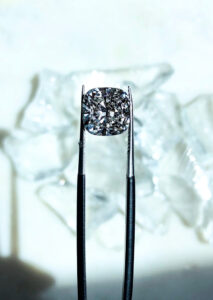
A symbol of love and luxury, diamonds are often used in engagement rings and other precious jewelry. While natural diamonds have been coveted for centuries, artificial diamonds are now becoming more and more popular. So what kind of chemical properties do artificial diamonds have compared to natural diamonds? Read along to know.
What Is An Artificial Diamond?
Artificial diamonds, also called synthetic diamonds, are diamonds that are created in a laboratory using advanced techniques. In contrast to natural diamonds, which take millions of years to form deep in the Earth’s mantle, artificial diamonds can be produced within weeks using a variety of methods.
Chemical Properties Of Natural Diamonds
Natural diamonds are composed entirely of carbon, with each carbon atom bonded to four adjacent carbon atoms in a strong three-dimensional crystal lattice. This structure gives diamonds unique physical and chemical properties such as hardness, high melting point, and excellent optical properties. One of the defining characteristics of natural diamonds is their clarity. Most natural diamonds contain impurities such as nitrogen, but the highest quality diamonds are those completely free of impurities and defects. These high-quality diamonds are known as Type diamonds and are valued for their rarity and excellent optical properties.
Chemical Properties Of Artificial Diamonds
One of the main differences between artificial and natural diamonds is their clarity. Natural diamonds take millions of years to form and are often completely free of impurities, whereas artificial diamonds are created in a matter of weeks and may contain traces of other elements. These impurities can affect the diamond’s color and other optical properties. Another difference between artificial and natural diamonds is their crystal structure. Both types of diamonds are composed of carbon atoms bonded in a crystal lattice, but the crystal structure of artificial diamonds may differ slightly from that of natural diamonds. This can affect the diamond’s physical properties such as hardness and density.
Artificial Diamonds Or Natural Diamonds?
Natural diamonds are often rare and expensive, but they have a long history as symbols of love and luxury. Lab-grown diamonds, on the other hand, are often less expensive and can be just as beautiful as natural diamonds. One advantage of artificial diamonds is that they are often more ethical and environmentally friendly than natural diamonds. The diamond industry has a history of human rights violations and environmental destruction, but artificial diamonds are created in a lab without these issues.
In conclusion, the chemistry of artificial diamonds is very similar to natural diamonds, but there are some important differences. Natural diamonds are prized for their clarity and superior optical properties, but artificial diamonds are just as beautiful and often more ethical and environmentally friendly. Ultimately, the choice between artificial and natural diamonds is personal and depends on personal preference and budget.
